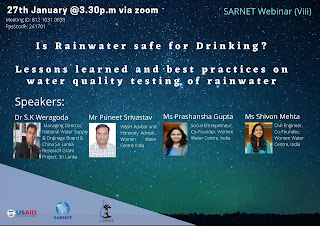Residents in Pune, in Maharashtra India, are proponents of water conservation and rainwater harvesting
Pune in Maharashtra India is blessed with an annual average rainfall of 900mm. While there was substantial rainfall the runoff waters ended up in drains without much use. It is one of the largest urban cities in Maharashtra. Though dams were constructed water availability was not consistent to meet the demand of the the entire area. In order to meet the growing demand due to rapid urbanization in the region the popularly adopted method adopted among residential groups in the city were to dig bore wells. The bore wells were extracting water 450 to 600ft below ground. The Groundwater Survey Department of Maharashtra was already sending warning signals about the likely depletion of groundwater resources.
Shashwat
Eco Solution
Foundation works in the environmental sector of sanitation, solid waste
management, and water harvesting in Pune Maharashtra. With the aim of making the
community sensitive to adopting Water conservation measures, this NGO conducts
a survey to identify the public perceptions and understanding of the importance
and technical knowledge of water rainwater harvesting. The survey findings reveal
that there is a lack of awareness among 50% of residents surveyed about rainwater
harvesting systems and no one had thought about implementing a rainwater
harvesting system. The surveyed participants were receiving Tap water supply
from Pune Corporation and the resident societies also were using water bore
wells. However, during the summer season, the water levels are insufficient
from the bore wells and the communities had to get water from the tanker from
March until there is rainy season starts with the monsoons. During the
consultations and capacity-building activities for the residents by the Shashwat
team the residents expressed their willingness to have rainwater harvesting
systems only to find restricted in meeting the cost. Shashwat’s team addressed
this challenge by introducing a subsidy model for societies. The Pune Corporation was involved in the entire
process. The intervention included saving water by stopping water leakages and recharging
the bore wells by adopting rooftop Rainwater Harvesting.
A
range of activities were done as part of a strategy to increase the residents’ awareness
of water conservation and to promote the adoption and viability of rainwater
harvesting among the target communities These activities included a rally, distributing around 5000 pamphlets through newspaper in
many zones of Pune city and the surrounding area, broadcasting advertisements
in popular radio channels, press conference that appealed the public the adopt
rainwater harvesting and newspaper article series on water conservation and
rainwater harvesting.
The awareness raising on water conservation and rainwater harvesting was followed by water conservation efforts and identifying the location and design for a rainwater harvesting system with the residents’ groups. Water conservation measures were discussed and agreed and the resident groups also consented to the design of the rainwater harvesting system in their society. The conservation efforts included water leakage detection and addressing, awareness raising on conscious consumption of water in washing, etc. The rainwater harvesting units adopted by the residential societies in the target locations included having a roof water collection system, first flush system, filtration, bore well recharging, and Overflow for percolation pit. Rainfall from the rooftop area is collected for harvesting. Mesh was installed at all connecting pipes at the rooftop to prevent any solid waste like paper, plastic, or glass from entering the system. The residents were informed of the operational aspects of the first flush device as it is a valve that ensures that runoff from the first spell of rain is flushed out and does not enter the system. The filtration tank to recharge the bore well consists of stones, bricks, and soil layers. It has pipe outlets covered with inner and outer mesh and a top covered with a lid to prevent external contamination. This filtration tank is above the ground and completely waterproof.
Following the construction of the
rainwater harvesting system sign boards were put up for each component of the
project site. Before the rainwater
harvesting system was handed over a member from the residential society along
with a society board member were trained on maintenance. The residential society members were also given
a report to be submitted to Pune Corporation the government representative in
the project team along with a guideline on Dos and Don’ts in using and
maintaining the rainwater harvesting system. A team member from Shashwat visited
all rainwater harvesting systems in the pre and post-monsoon to assess the
functioning of the system and dual flush valve. This initiative directly benefits around 2000
residents in Pune.
Sharing this
experience at the recently concluded 2nd international conference of
the South Asia Rainwater Network in May 2023 in Sri Lanka Ms. Pradnya Thakur Director
of Shahswat Eco Solutions highlighted the importance of community engagement
and ownership in the long term: “The technology is important but apart from
that community ownership and engagement for long-term maintenance is important”.
Having rainwater harvesting systems not only helps
to increase water availability but helps in tanker cost, bringing a saving in the
electricity bill as there is no use of a pump from the bore well during the dry
season which leads to improvement in groundwater quality by replenishing
freshwater recharge. Failure to use rainwater will lead to runoff ending up in
drains and turning into wastewater – in other words, a larger greywater
footprint. The rainwater used to recharge the underground water
table shifts the green water usage to blue water while avoiding the wastage of
green water. The rainwater stored can be used to replace the extraction of groundwater
and hence blue water usage is replaced by green water and blue water usage is
optimized.





Comments
Post a Comment